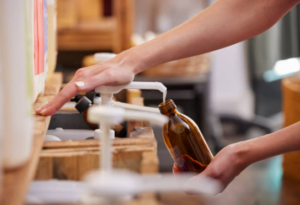Packaging for the Planet

In a world where environmental awareness and sustainable living have become central to our everyday choices, the beauty industry is undergoing a profound transformation. With a growing emphasis on reducing waste and minimizing environmental impact, beauty brands are embracing sustainable packaging as a way to meet the demands of eco-conscious consumers. In this beauty blog, we’ll explore the beauty industry’s evolving relationship with packaging and delve into the innovative solutions that are making a positive impact on our planet.
The Beauty Industry’s Packaging Predicament
The beauty industry, while celebrated for its ability to make us look and feel our best, has long grappled with a dark side – excessive packaging, single-use plastics, and a significant disregard for the environmental repercussions of its actions. In this section, we’ll delve deeper into the issues that have plagued the industry’s packaging practices, helping to shed light on the severity of the problem.
- Plastic Predicament: Perhaps the most glaring issue within the beauty industry’s packaging practices is its overreliance on single-use plastics. Walk into any cosmetics store, and you’ll encounter a sea of products encased in non-recyclable plastic containers. From makeup compacts to shampoo bottles, millions of these plastic products are sold every year, contributing significantly to the planet’s plastic waste crisis.The consequences of this plastic predilection are dire. Plastic pollution is a global menace, with plastic waste infiltrating every corner of our planet, from pristine oceans to remote wilderness areas. It not only clogs waterways and poses a threat to marine life but also releases harmful chemicals into the environment as it degrades, further exacerbating the environmental impact.
- Energy Consumption: Beyond the sheer volume of plastic used, the energy required for the production and disposal of conventional packaging materials is staggering. The creation of plastics, aluminum, and glass packaging involves the consumption of vast amounts of energy and natural resources. This not only drives up carbon emissions but also contributes to the depletion of finite resources.
- Microplastic Pollution: The beauty industry’s connection to microplastic pollution is often overlooked. Many cosmetic and skincare products, particularly exfoliants and scrubs, contain microplastics – tiny plastic particles that provide abrasive qualities. When these products are washed down the drain, these microplastics find their way into rivers and oceans, where they are ingested by aquatic life and enter the food chain, posing a threat to human health.
- Landfill Waste: The journey of non-recyclable packaging materials typically ends in landfills, where they can linger for hundreds of years. With modern beauty consumers constantly seeking the latest products and packaging that are designed for aesthetics rather than sustainability, the problem of waste in landfills is only growing.The beauty industry’s embrace of disposable packaging has dire consequences, as landfills continue to overflow with products that could take centuries to decompose. This contributes to soil pollution and prevents the efficient use of landfill space.

Innovations in Sustainable Packaging
Consumers worldwide are demanding sustainable alternatives. They are pressuring beauty brands to be more accountable for the environmental impact of their products. In response to this demand, the beauty industry is taking significant strides towards more sustainable packaging.
- Refillable Packaging: Many beauty brands have adopted refillable packaging systems that allow customers to purchase refills instead of entirely new products. This approach reduces waste and encourages the reuse of containers. Brands like Fenty Beauty, for instance, offer refillable options for their products.
- Biodegradable and Compostable Materials: Brands are exploring biodegradable materials like cornstarch, sugarcane, and algae-based plastics for packaging. These materials break down naturally, reducing the environmental impact of discarded packaging.
- Recycled Materials: Beauty brands are increasingly using recycled materials for their packaging. Recycled plastic, glass, and aluminum are being used to create stylish and eco-friendly packaging.
- Reducing Packaging: Simplifying product packaging by eliminating unnecessary layers and materials is another trend. Minimalist packaging not only saves resources but also resonates with consumers seeking less clutter and waste.
- Bamboo and Wood: For cosmetics and skincare, bamboo and wood are being used for packaging, offering an elegant and sustainable alternative to plastic.
- Aluminum and Glass: Aluminum and glass containers are gaining popularity for their recyclability and durability. Many brands now use these materials to house their products, reducing the need for single-use plastics.

The Future of Sustainable Beauty
The beauty industry, long characterized by its often excessive use of resources and non-recyclable packaging, is undergoing a profound transformation towards sustainability. As the world grapples with environmental challenges, consumers are increasingly seeking products that align with their values, and beauty brands are heeding the call for more sustainable practices. In this section, we’ll explore the concept of sustainable beauty and the innovations that are reshaping the industry.
- Clean Beauty Movement: The clean beauty movement is gaining momentum, focusing on products that prioritize safety, transparency, and sustainability. Clean beauty brands are committed to using non-toxic ingredients, transparent sourcing, and sustainable packaging. They aim to reduce the environmental impact of beauty products while prioritizing consumer safety.Brands within this movement often embrace cruelty-free, vegan, and organic ingredients. They avoid harmful chemicals and controversial ingredients, providing eco-conscious consumers with products that align with their values.
- Natural and Sustainable Ingredients: In addition to packaging, the beauty industry is embracing natural, sustainable ingredients that are sourced responsibly. Brands are exploring partnerships with sustainable farms and communities to ensure ethical ingredient sourcing. This commitment to ethical ingredient production not only benefits the environment but also supports local communities.
- Responsible Manufacturing Practices: Sustainability in the beauty industry goes beyond the product itself; it encompasses the entire supply chain. Brands are focusing on sustainable manufacturing processes, responsible waste management, and reduced energy consumption to minimize their carbon footprint.
- Eco-Friendly Initiatives and Certifications: Many beauty brands are seeking third-party certifications, such as cruelty-free and organic certifications, to validate their commitment to sustainability. These certifications provide consumers with reassurance that they are supporting brands that uphold ethical and eco-friendly principles.
- Circular Economy Initiatives: The beauty industry is also exploring circular economy models, where products and packaging are designed with recycling and repurposing in mind. Brands are increasingly participating in take-back programs, encouraging customers to return empty containers for recycling or upcycling in exchange for rewards.
- Clean Water Initiatives: Recognizing the importance of water conservation, beauty brands are investing in clean water initiatives to reduce water waste in production processes and actively contribute to global water sustainability.
- Social Responsibility: Sustainable beauty also extends to social responsibility, with many brands focusing on ethical and fair labor practices, supporting communities, and contributing to charitable causes.
Sustainable beauty isn’t just a passing trend; it’s a fundamental shift in the way the beauty industry operates. Brands are realizing that sustainability isn’t merely a buzzword but a necessary response to a changing world and more informed, eco-conscious consumers. The future of beauty lies in making responsible choices, embracing eco-friendly packaging, and using products that not only enhance our appearance but also contribute to a healthier planet.

The transition towards sustainable packaging in the beauty industry is not a fleeting trend; it is the future. As consumers become more eco-conscious, brands must align their values with these changing consumer preferences. Beauty brands are beginning to understand that eco-friendly packaging is not only about reducing waste and pollution but also about creating products that resonate with the conscious consumer.
Choosing brands that prioritize sustainability in packaging not only helps the planet but also elevates the overall beauty experience. The future of beauty lies in making responsible choices, embracing sustainable packaging, and using products that not only enhance our appearance but also contribute to a healthier planet.
In conclusion, the beauty industry’s commitment to sustainable packaging is a reflection of the evolving values of both brands and consumers. It’s a win-win for the beauty industry and the environment. The innovative packaging solutions discussed here represent the industry’s positive steps towards a more sustainable and responsible future, where beauty and sustainability go hand in hand. Embrace the future of beauty and join the movement towards more sustainable and responsible beauty choices. Your skin and the planet will thank you.

